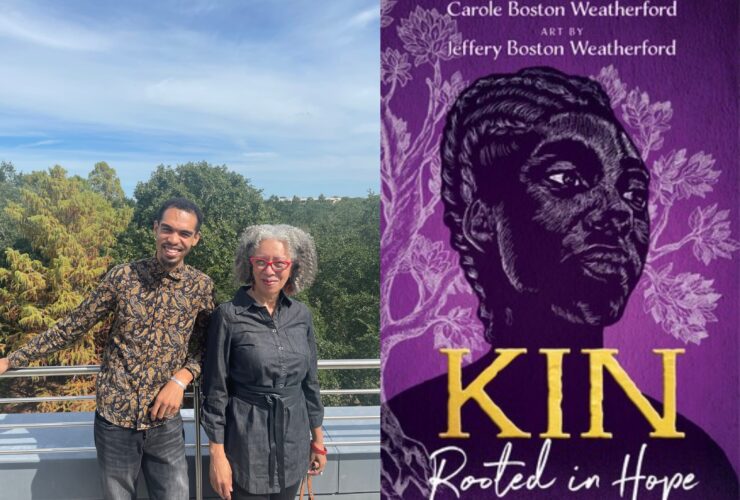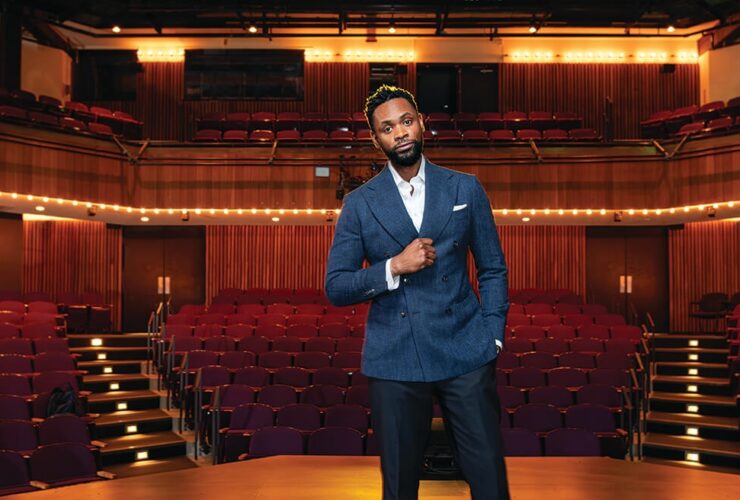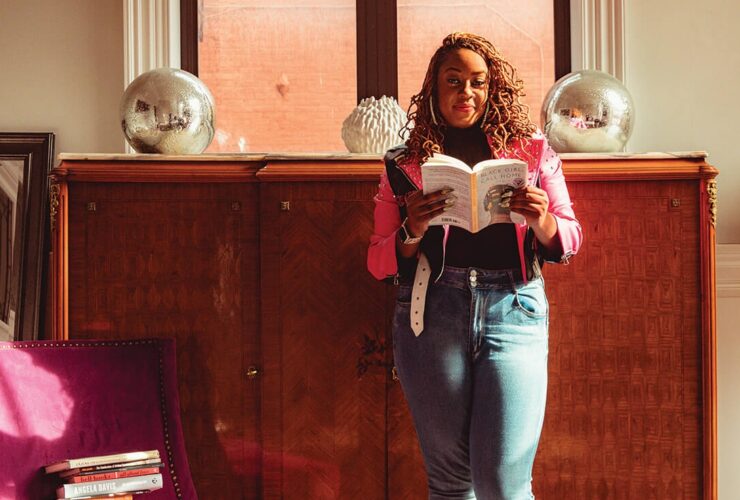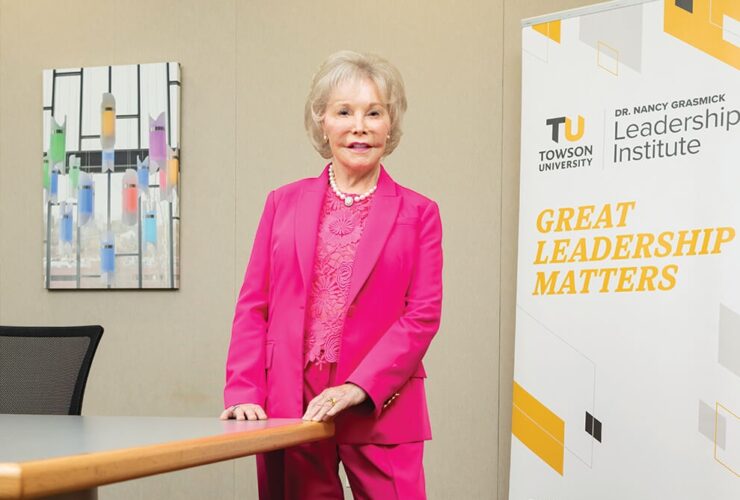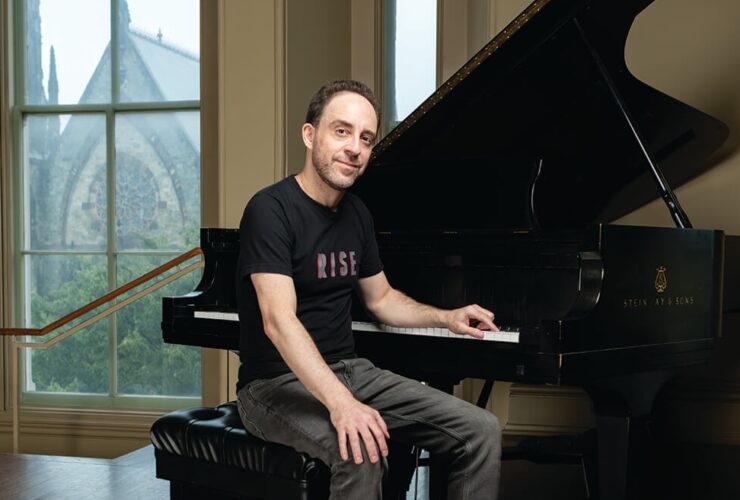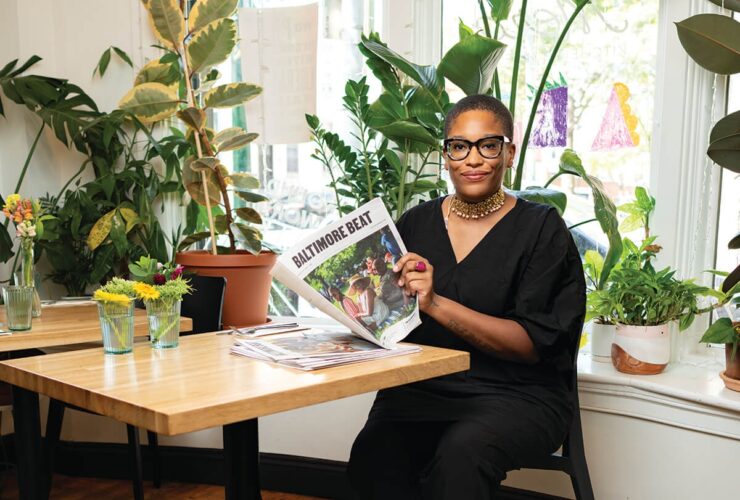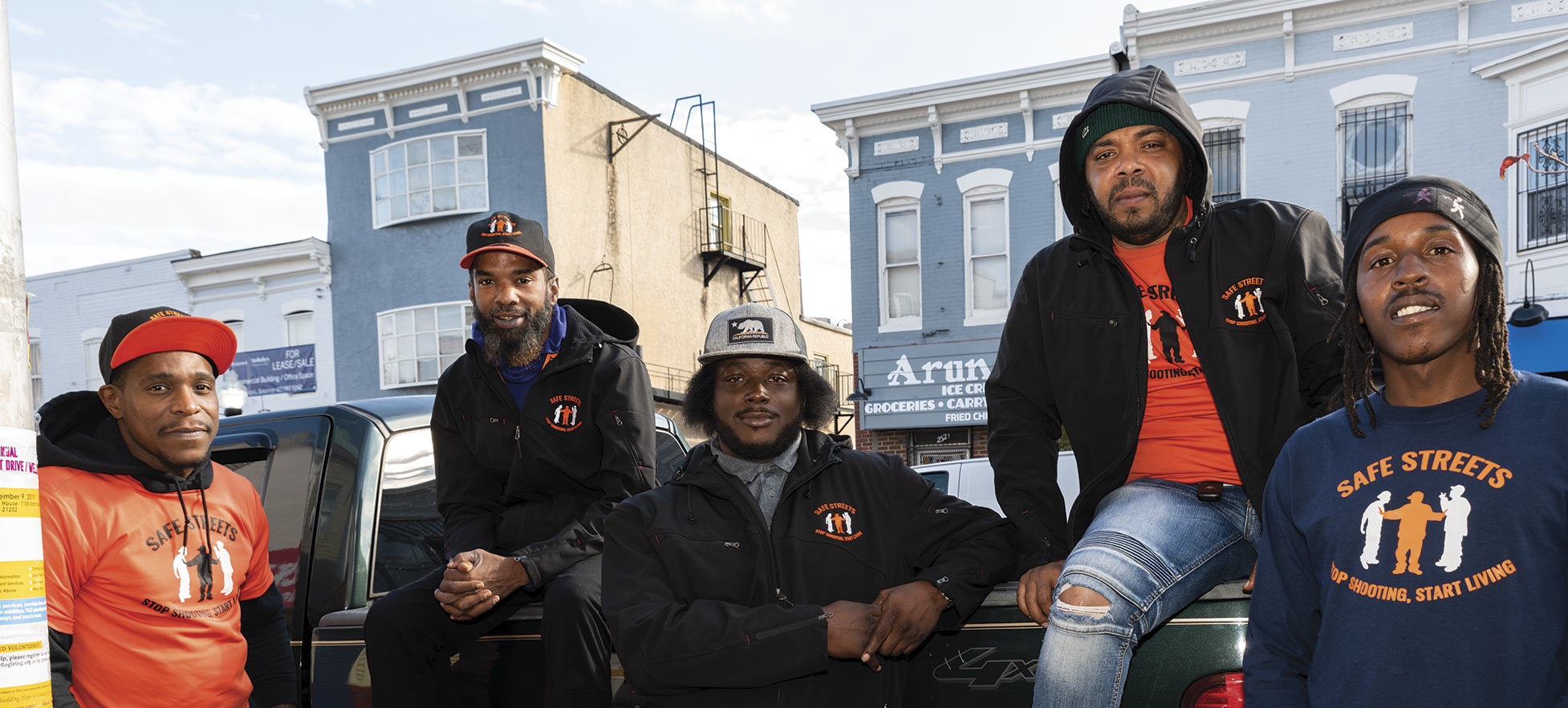
Don’t Take it Outside.
Safe Streets Baltimore aims to end city violence by treating it as a public health epidemic
GameChangers
Don’t Take it Outside.
Safe Streets Baltimore aims to end city violence by treating it as a public health epidemic
Christianna McCausland
Photography by Mitro Hood
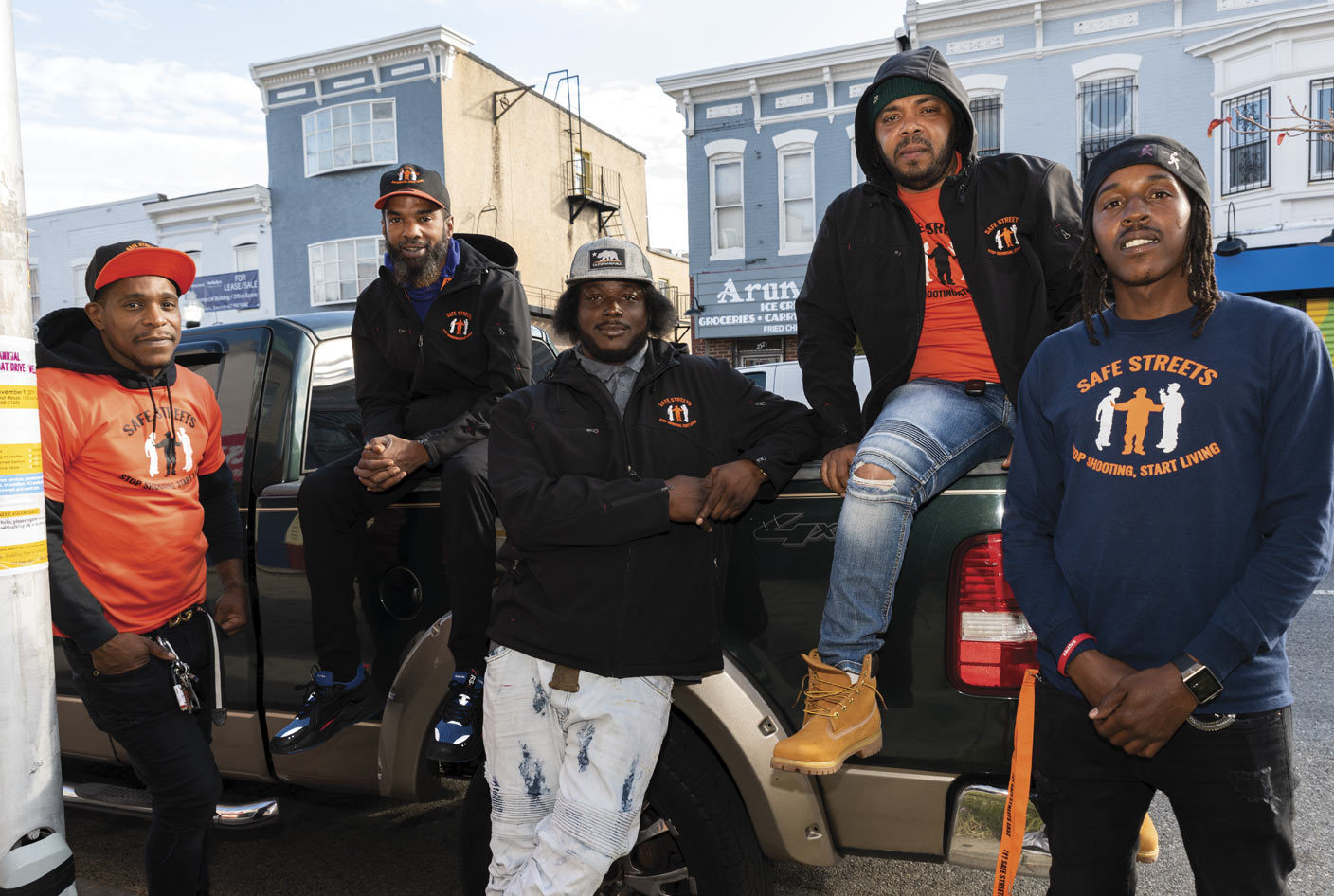
Gardnel Carter can still recall his first anti-violence mediation at McElderry Park’s Safe Streets site in East Baltimore. Recently released from prison, he was well-suited to the job of canvassing the community looking for high-risk youth in danger of committing violence. After all, he’d been in their shoes.
As a Safe Streets “Violence Interrupter” (VI), it was Carter’s job to step between warring parties, de-escalate the tension, and mediate a peaceful solution so no one got shot. At the time, in 2007, the program was new and had yet to gain the trust of the neighborhood. But Carter had to put his training to the test.
“One of my clients [he refers to residents he’s working with as clients] I was working with got in it with a major player—he was thinking he was going to lose his life,” Carter recalls.
Carter called for a mediation at the office and was waiting with his client, the client’s two friends, and his Safe Streets teammates for the opposing person to arrive. He didn’t come, but he sent 15 members of his crew instead—and they didn’t want to talk.
“I said, ‘Not in here, we’re here to squash this kind of stuff,’” Carter recalls. “We asked, ‘Who are the shot callers?’ and then we sent everyone else outside. Eventually, the main guy came and he walked straight up on my guy like he was going to smack everything out of him and my guys were like, ‘Hold up bra’—you can’t do this, this isn’t how it works.’”
Eventually, everyone sat down and it became clear the grievance was based on misinformation. And the two men talked out a solution.
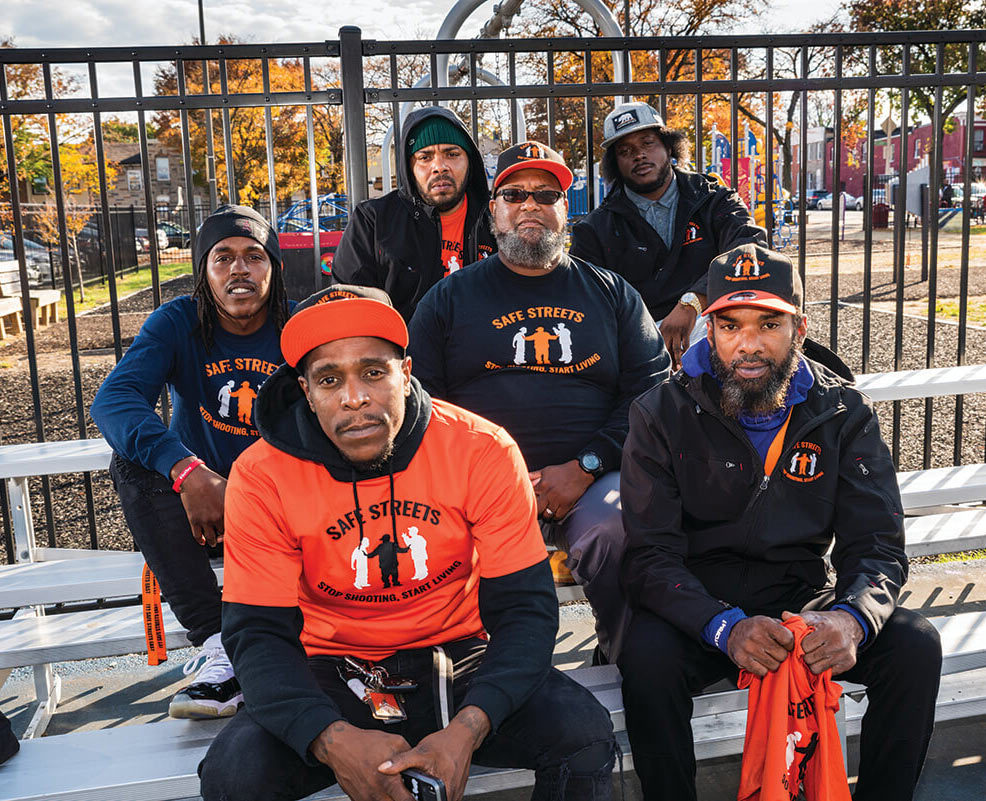
Front (L to R): Kennard Miles and David Fitzgerald. Middle: Calvin Harper and Gardnel Carter. Back row: Jason Carr and Alex Long.
“When it was all settled, those guys spread the word on the street about Safe Streets saying, ‘These guys don’t want us killing each other. They’re not here to stop us from hustling or anything, they just want to take the violence out of our everyday situations,’” says Carter, who is now the site’s director. “That spread all over this area.”
Thereafter, the McElderry Park Safe Streets zone went 23 months without a single homicide.
McElderry Park was the first Safe Streets location, opened in partnership with the Baltimore City Health Department and Living Classrooms Foundation (LCF). There are now eight sites throughout Baltimore City, four of which opened last year alone. In 2018, then-Mayor Catherine Pugh moved the program to the Mayor’s Office of Criminal Justice for funding purposes, but the program remains committed to treating violence as a public health problem.
“We see violence as a contagion and it makes communities sick by spreading from one person to another,” says Dedra Layne, director of Safe Streets Baltimore in the Mayor’s Office of Criminal Justice. “We use the same approach to deal with a contagion that the World Health Organization uses to treat an epidemic.”
Layne explains the three-pronged approach: Identify individuals at high risk for violent behaviors (mostly young men ages 14 to 25 with a history of violence, gang activity, and incarceration), interrupt and intervene in potentially violent conflicts with mediation, and then work to change community norms around the acceptance of violence.
The work happens on the street, but the program is data-driven. After canvassing, VIs input their interactions into a database analyzed by the mayor’s office. Data for the first 10 months of 2019 shows the program’s efficacy, reporting 1,387 conflict mediations. Most zones report marked decreases in shootings and homicides compared to their neighbors.
Safe Streets also employs VIs as hospital responders at three area medical centers to support victims. Layne says this is successful at curbing retaliatory acts of violence after a person is released from the hospital and improves the chances the victims will seek follow-up care.
It’s no mistake that Safe Streets applies a public-health model. It’s based on a program begun in Chicago originally called CeaseFire, now Cure Violence, founded by physician Gary Slutkin, former head of the WHO’s Intervention Development Unit and a professor at the University of Illinois at Chicago School of Public Health. Baltimore was an early adopter of the program and Cure Violence conducts the 40-hour training for new Safe Streets staffers and subsequent booster trainings.
The model is rooted in the belief that violence is a behavior, like smoking or exercise, that is unconsciously copied so that it begets more violence. By interrupting violence, it gives potential shooters not only a chance to cool down but also to learn a better way of handling disputes.
“It’s critical that we have an understanding not only that gun violence is occurring but the reasons why it’s occurring...”
“We see violence as a learned behavior, and to unlearn it, you have to replace it with an alternate way of being,” says Layne. “Historically, we’ve worked in our country to eradicate violence with policing. We see that is not the only answer.”
The Sandtown-Winchester site is housed in a tidy former rectory overlooking Pennsylvania Avenue. Across the street are deserted homes, partially boarded-up, their windows black and empty. Standing on the steps outside, program manager Imhotep Fatiu’s passion is palpable. He wants Safe Streets to become a Baltimore movement, a wave that turns the city around.
“There’s not a single person in the city of Baltimore who can’t benefit from a reduction in shootings and homicides,” he says. “Schools, churches, businesses. Who wants to send their child to school if they keep finding bodies on the playground? How do you make money if they keep killing people outside your business?
“If we don’t get behind this now while we have a chance to, it’s a disease and it will spread.”
On a cold, wet day in October, the VIs at McElderry Park gather for their pre-canvas briefing in their signature black jackets with their bright orange logos. Across the street, a police car’s lights flash; a store was burgled earlier that day. A handful of kids file in and play on the boxing equipment. Resident Gardnel Carter says he sees the area trying to rebound and the VIs see the success of the program all around them.
“We’re all from around here and the block we hang on, our friends, they’re all employed now,” says Kennard Miles, a current VI. “We all still hang out—but only after work.”
His colleague, Alex Long, lost a sister to gun violence. He sees a neighborhood ready for peace.
“The residents want change,” says Long. “They’re tired of the gunfighting.”
And that speaks to the VI’s single mission: to stop people from shooting each other. They are not on the street to convince people to stop selling drugs. They don’t “snitch” to the police. They aren’t even there to get someone a job or a bed in a rehab, though they often do. Many staff members have their own history of street life and incarceration and have seen their families affected by gun violence. It’s these close ties to the realities of life in the neighborhood that give the VIs the credibility they need to do their work.
“When we say we’re looking for high-risk individuals, that means we’re looking for the shooters or those who may get shot,” says Carter. “The shooters is a short list ’cause we know all the shooters. But the ones who are going to get shot could be a long list, so it’s important for all of us who work here to know everyone in this neighborhood. Building relationships is key.”
The work is dangerous. VIs at McElderry Park recall a recent workday when they were tipped off about a nearby beef. As they walked around the corner to mediate, they heard gunshots and ducked behind cars for safety. Staff don’t wear bulletproof vests or carry weapons. Respect and the signature black and orange uniform are the VIs’ only protection.
“We really make an effort to hire the correct people because your armor is your credibility,” says Fatiu. “Your credibility doesn’t make you bulletproof but it minimizes a lot of the danger.”
The Safe Streets staff works a 40-hour week but the hours vary depending on when there are spikes in violence. Each site operates under the auspices of a nonprofit partner, which also helps with programmatic partnerships, providing connections to workforce development programs, for example.
McElderry Park is one of two sites overseen by the Living Classrooms Foundation (LCF). LCF president James Bond explains that while his organization provides everything from job-creation programs to community centers, the biggest issue needs to be addressed head-on. “If you’re really going to disrupt the cycle of poverty, you have to deal with the elephant in the room, the shootings and killings,” says Bond. “And this was a direct way to do it.”
Bill McCarthy, executive director of Catholic Charities, which oversees two other sites, says he appreciates that the program gets to the heart of reversing gun violence.
“It’s critical that we have an understanding not only that gun violence is occurring but the reasons why it’s occurring and how people aren’t equipped in many cases to resolve conflict in ways that are healthier, less traumatic, and, frankly, less irreversible.”
The Safe Streets model is so tied to relationships that Fatiu, now program manager at the Sandtown-Winchester site, one of the city’s largest with 11 employees, almost turned down the job. Fatiu turned his life around while in prison and returned to his community ready to impact youth and save lives, but Safe Streets wanted him to work at McElderry Park and Fatiu was from Park Heights. His passion for the work overrode his misgivings and he’s gone on to work in several Safe Streets sites.
Fatiu says the Safe Streets model can be boiled down to a simple equation: Daily canvasing by VIs plus building rapport in the community multiplied by mediations equals a reduction in shootings and homicides.
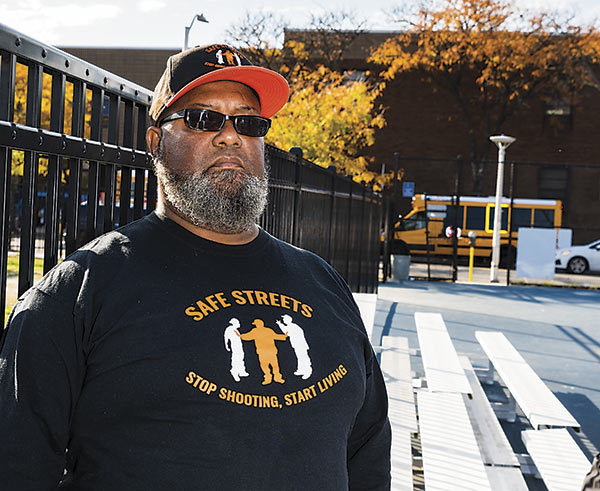
“That’s infallible,” Fatiu states. “If a person is doing that, they’ll see results.”
But there’s a second equation that’s just as important.
“Daily canvasing plus community safe walks multiplied by community events, equals community buy-in,” he explains.
Last year, the combined sites conducted more than 226 community events—basketball tournaments, movie screenings in public housing, black-author expos, and Halloween haunted houses. All sites have giveaways of shoes, diapers, backpacks, and other essentials. At McElderry Park, VI Alex Long runs a boxing gym with clinics for kids.
The community buy-in fostered by these events helps workers do their job and models another way of living, one that’s less violent and more communal.
“Safe Streets Baltimore represents an opportunity of redemption for the men and women who do this work,” says Layne, “and they thereby present a mirror for people who are struggling with a way to see themselves out of the chaos. They see someone who’s been in their shoes, who’s done what they’re doing, which gives them the hope and the ability to do things differently.”
Safe Streets maps crime to understand what’s happening in and around its zones. The program says no one takes a conflict outside the zone to settle it elsewhere, hopefully because of residents’ respect for Safe Streets.
“If you’re squashing a beef between two people, they won’t go to the next block to outwit Safe Streets,” says Ganesha Martin, director of the Mayor’s Office of Criminal Justice.
The VIs are clear in what they want: more sites and more wraparound services. While jobs alone won’t stop violence—plenty of employed people in America commit violent crimes—an efficient, comprehensive pipeline to resources such as jobs, housing, and drug rehabilitation is needed.
“If someone lives off the gun and he puts the gun down, we may not like to hear it, but we’ve taken away his livelihood,” says Fatiu. “We need to instantly replace it or he’ll pick the gun back up.”
Long, the VI at McElderry Park, says the program is respected and residents expect Safe Streets to deliver on its promises. That means building out more resources.
“In order for Safe Streets to be effective, we need partners,” says Long. “As long as our community is depleted you’ll have spikes in violence.”
A solution may be forthcoming. Martin says she’s currently working to create a single resource to connect those in need.
“With Safe Streets, it’s often an ad hoc response—is there a job here? Do you have some housing over there? That’s not a robust, programmatic response to the violence in our city and we need to do better,” concedes Martin. “I’m working on a service-provider network specifically aimed at providers who can help folks who are stuck in this epidemic of violence.”
